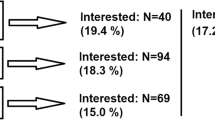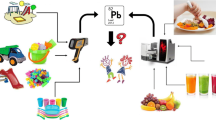Abstract
Lead is a highly toxic metal, the main source of which iscontamination from combustion of unleaded petrol.The aims of this work were todetect the degree of lead exposure in a large sample of children; determinetherelationship between blood lead levels (BPb) and age, sex, habitat and season of the year;andcorrelate BPb with zinc protoporphyrin (ZPP) values. A cross-sectional study wascarried out. Blood fromroutine extractions drawn at our centre was used. BPb and ZPP weremeasured by atomic absorptionspectrophotometry and haematofluorimetry,respectively. We analysed 1158 blood samples from children.BPb (mean ± SEM): 0.22 ±0.04 μmol l . Correlation BPb-age: BPb = 0.19 + 0.086 x age (months),r =0.129, P < 0.0001. BPb was greater in boys (0.23 ± 0.007 versus 0.20 ±0.006 μmol l , P < 0.0002).No differences were observed between habitats(urban versus rural). BPb were higher in the warm months(0.24 ± 0.013versus 0.21 ± 0.007 μmol l , P < 0.0001). Prevalence of lead intoxication (BPb > 0.48 μmol l )was 4.2%. No differences in prevalence were found among the different groups. The correlationbetweenBPb and ZPP showed r = 0.0969, P = 0.0024. Utility for screening:sensitivity of 53.7% and specificity of 59.3% (cut-off point of 60 μmol ZPPmol haem). We can conclude that lead exposure in children inoursample was in the range reported in similar studies in other areas andcountries, and below the toxic limit.None of the factors analysed significantlyinfluenced lead intoxication prevalence. There was no goodcorrelationbetween ZPP and BPb in our sample and the ZPP cut-off point used did not presentgoodspecificity and sensitivity values.
Similar content being viewed by others
References
Al-Saleh I, Khalil MA, Taylor A. 1995 Lead, erythrocyte protoporphyrin, and hematological parameters in normal maternal and umbilical cord blood from subjects of the Riyadh region, Saudi Arabia. Arch Environ Health 50, 66-73.
American Academy of Pediatrics. 1987 Committee on Environmental Hazards. Committee on Accident and Poison Prevention: Statement on childhood lead poisoning. Pediatrics 79, 457-465.
Baghurst PA, McMichael AJ, Wigg NR, et al. 1992 Environmental exposure to lead and children's intelligence at the age of seven years. The Port Pirie Cohort Study. N Engl J Med 327, 1279-1284.
Banno DI, Murashchik C, Zapf CR, Farfel MR, Chisolm JJ. 1994 Graphite furnace atomic absorption spectroscopic measurement of blood-lead in matrix-matched standards. Clin Chem 40, 1730-1734.
Bellinger DC, Stiles KM, Needleman HL. 1992 Low-level lead exposure, intelligence and academic achievement: a long-term follow-up study. Pediatrics 90, 855-861.
Blumberg WE, Eisinger J, Lamola AA, Zuckerman DM. 1977 Zinc protoporphyrin level in blood determined by a portable hematofluorometer: a screening device for lead poisoning. J Lab Clin Med 89, 712-723.
Braithwaite RA, Brown SS. 1988 Clinical and sub-clinical lead poisoning: a laboratory perspective. Human Toxicol 7, 503-513.
Brody DJ, Pirkle JL, Kramer RA, et al. 1994 Blood lead levels in the US population. Phase 1 of the third National health and nutrition examination survey (NHANES III, 1988 to 1991). JAMA 272, 277-283.
Burke N. 1993 Children's blood lead levels and environmental lead contamination. Med J Aust 159, 144.
Cabeza JM, Espinosa E, Villanueva F, Vazquez L, García MA. 1991 Lead and zinc protoporphyrin in the blood of a rural child population in Asturias, Spain. Sci Total Environ 107, 91-98.
Cambra K, Alonso E. 1995 Blood lead levels in 2-to 3-year-old children in the Greater Bilbao Area (Basque Country, Spain): relation to dust and water levels. Arch Environ Health 50, 362-366.
Centers for Disease Control. 1991 Preventing lead poisoning in young children. A statement by the Centers for Disease Control, US Department of Health and Human Services, Atlanta.
Centers for Disease Control. 1997 Screening young children for lead poisoning: Guidance for state and local public health officials. US Department of Health and Human Services, Public Health Service, Atlanta.
Charney E, Kessler B, Farfel M, et al. 1983 Childhood lead poisoning: A controlled trial of the effect of dust-control measures on blood lead levels. N Engl J Med 309, 1089-1093.
Commission of European Communities. 1983 Directive on lead. The safety prohibition 1, 48.
Davis JM, Elias RW, Grant LD. 1993 Current issues in human lead exposure and regulation of lead. NeuroToxicology 14, 15-28.
Dietrich KN, Krafft KM, Bornschein RL, et al. 1987 Low-level lead exposure effect on neurobehavioral development in early infancy. Pediatrics 80, 721-730.
Dietrich KN, Succop PA, Berger OG, Keith RW. 1992 Lead exposure and the central auditory processing abilities and cognitive development of urban children: the Cincinnati lead study cohort at age 5 years. Neurotoxicol Teratol 14, 51-56.
Dietrich KN, Berger OG, Succop PA. 1993 Lead exposure and motor developmental status of urban six-year-old children in the Cincinnati prospective study. Pediatrics 91, 301-307.
Faust D, Brown J. 1987 Moderately elevated blood lead levels: effects of neuropsychologic functioning in children. Pediatrics 80, 623-629.
Folinsbee LJ. 1992 Human health effects of air pollution. Environ Health Perspect 100, 45-56.
Fulton M, Thomson G, Hunter R, et al. 1987 Influence of blood lead on the ability and attainment of children in Edinburgh. Lancet i, 1221-1225.
Generalitat de Catalunya. 1995 Departament de Medi Ambient. Direcció General de Qualitat Ambiental. Xarxa de vigilància i prevenció de la contaminació atmosfèrica a Catalunya. Resum anual. Barcelona.
Jin A, Hertzman C, Peck SHS, Lockitch G. 1995 Blood lead levels in children aged 24 to 36 months in Vancouver. Can Med Assoc J 152, 1077-1086.
Kammholz LP, Thatcher LG, Blodgett FM, Good TA. 1972 Rapid protoporphyrin quantitation for detection of lead poisoning. Pediatrics 50, 625-631.
Landrigan PJ, Graef JW. 1987 Pediatric lead poisoning: The silent epidemic continues. Pediatrics 79, 582-583.
Leung FY, Bradley C, Pellar TG. 1993 Reference intervals for blood lead and evaluation of zinc protoporphyrin as a screening test for lead toxicity. Clin Biochem 26, 491-496.
Leviton A, Bellinger D, Allred EN, et al. 1993 Pre-and postnatal low-level lead exposure and children's disfunction in school. Environ Res 60, 30-43.
Lockitch G. 1993 Perspectives on lead toxicity. Clin Biochem 26, 371-381.
Mauras Y, LeBouil A, Mariotte N, Tichet J, Autret E. 1995 Etude de la plombémie dans une population de 616 sujets des régions Centre et Pays de Loire. Presse Med 24, 1639-1641.
McElvaine MD, Orbach HG, Binder S, et al. 1991 Evaluation of the erythrocyte protoporphyrin test as a screen for elevated blood lead levels. J Pediatr 119, 548-550.
McMichael AJ, Baghurst PA, Wigg NR, et al. 1988 Port Pirie cohort study: environmental exposure to lead and children's abilities at the age of four years. N Engl J Med 319, 468-475.
Ministerio de Industria y Energía. 1988 Real Decreto 1513/1988 de 9 de diciembre, por el que se establecen nuevos contenidos máximos de plomo en las gasolinas. BOE 19/12/1988; no 303: pp. 35518.
MMWR (Morbidity and Mortality Weekly Report). 1997 Update: blood lead levels - United States, 1991-1994. MMWR 46, 141-146.
Needleman HL. 1993 The current status of childhood lead toxicity. Advances in Pediatrics, Vol 40. St Louis, MA: Mosby-Year Book Inc.; 125-139.
Needleman HL, Gatsonis CA. 1990 Low-level lead exposure and the IQ of children. A meta-analysis of modern studies. JAMA 263, 673-678.
Needleman HL, Gunnoe C, Leviton A, Allred EN. 1979 Deficits in psychologic and classroom performance of children with elevated dentine lead levels. N Engl J Med 300, 689-695.
Norman EH, Bordley WC. 1995 Lead toxicity intervention in children. J R Soc Med 88, 121-124.
Norman EH, Bordley WC, Hertz-Picciotto I, Newton DA. 1994 Rural-urban blood lead differences in North Carolina children. Pediatrics 94, 59-64.
Ordóñez JM, Aparicio MI, Daponte A, Rodriguez G, Perales R. 1993 Plomo en sangre de población materno-infantil de la Comunidad de Madrid. An Esp Pediatr 39(S55), 97-100.
Rabinowitz MB, Wang JD, Soong WT. 1991 Dentine lead and child intelligence in Taiwan. Arch Environ Health 46, 351-360.
Rabinowitz MB, Wang JD, Soong WT. 1992 Children classroom behaviour and lead in Taiwan. Bull Environ Contam Toxicol 48, 282-288.
Redondo MJ, Guisasola FJA. 1995 An unknown risk group of lead poisoning: the gypsy children. Eur J Pediat 154, 197-200.
Redondo MJ, Blanco A, Alvarez FJ. 1995 Relación de la plumbemia con la etnia gitana y otros factores epidemiológicos. An Esp Pediatr 42, 22-26.
Rifai N, Faser C, Cohen G, Wolf M, dePalma L. 1992 Lead poisoning in young children in Washington DC: a crisis that remains to be addressed. AJDC 146, 1259-1260.
Rivas JA, Rivas MF, Crespo M. 1993 Epidemiología del saturnismo infantil en Asturias. An Esp Pediatr 38, 390-393.
Rodamilans M, Torra M, To-Figueras J, et al. 1996 Effect of the reduction of petrol lead levels of the population of Barcelona (Spain). Bull Environ Contam Toxicol 56, 717-721.
Sayre JW, Charney E, Vostal J, Pless IB. 1974 House and hand dust as a potential source of childhood lead exposure. Am J Dis Child 127, 167-171.
Schuhmacher M, Domingo JL, Llobet JM, Corbella J. 1992 Lead concentration and d-aminolevulinic acid dehydratase in the blood of general population of Tarragona province, Spain. Sci Total Environ 116, 253-259.
Sciarillo WG, Alexander G, Farrell KP. 1992 Lead exposure and child behaviour. Am J Public Health 82, 1356-1360.
Shy CM. 1990 Lead in petrol: the mistake of the XXth century. Rapp Trimest Statist Sanit Mond 43, 168-176.
Turk DS, Schonfeld DJ, Cullen M, Rainey P. 1992 Sensitivity of erythrocyte protoporphyrin as a screening test for lead poisoning. N Engl J Med 326, 137-138.
Wasserman G, Graziano JH, Factor-Litvak P, et al. 1992 Independent effects of lead exposure and iron deficiency anemia on developmental outcome at age 2 years. J Pediatr 121, 695-703.
Wietlisbach V, Rickenbach M, Berode M, Guillemin M. 1995 Time trend and determinants of blood lead levels in a Swiss population over a transition period (1984-1993) from leaded to unleaded gasoline use. Environ Res 68, 82-90.




